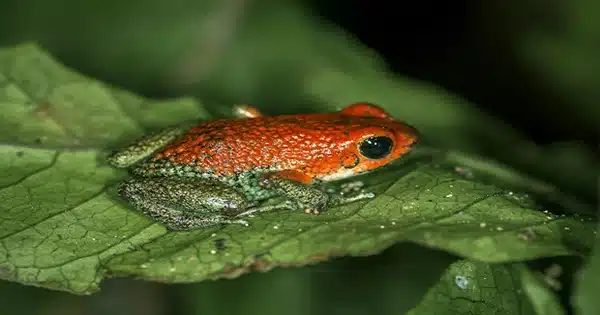The evolution of bright colors in animals is a fascinating area of study, and there are a few different explanations for how these animals can evolve without being eaten.
One possible explanation is that bright colors can serve as a warning to potential predators. Many animals have evolved bright colors to advertise their toxicity, venomous nature, or unpalatability. Predators learn to associate these bright colors with a bad taste or a toxic reaction, and they avoid attacking these animals in the future.
Another explanation is that bright colors can help animals to blend in with their environment. For example, some brightly colored animals, like poison dart frogs, live in environments that are already very colorful, such as the rainforest. These animals have evolved to match the colors of their surroundings, making them harder for predators to spot.
Finally, some animals have evolved bright colors as a form of sexual selection. In these cases, the bright colors are not intended to deter predators, but rather to attract potential mates. Brightly colored feathers, scales, or fur can signal to potential mates that an animal is healthy and strong, and therefore a good mate.
How animals were able to develop bright colors to alert predators of their toxic nature has reportedly been solved by a trio of evolutionary biologists, two from Carleton University and the third from Seoul National University. Over 1,000 frog, salamander, and newt species’ family trees were examined by Karl Loeffler-Henry, Changku Kang, and Thomas Sherratt for their paper research, which was later published in the journal Science.
Evolutionary scientists have been perplexed by the apparent contradiction of aposematism for a long time. Animals like frogs use bright colors to alert potential predators that ingesting them will make them sick or even kill them. How could these hues have developed? Animals that stick out are often the first to be captured and eaten, which prevents the evolution of even more vibrant colors. The study team sought to find the answer to this conundrum in this new endeavor.
The research involved looking for evidence of the evolution of aposematism in 1,100 species of frogs, salamanders, and newts in a novel way by breaking them down into five categories instead of two, namely conspicuous, cryptic, partially conspicuous, fully conspicuous, and polymorphic.
They discovered that several animals with aposematism had no color or hidden colors in their ancestors. The ancestors of those who had color had colors that could be exhibited as needed. These animals frequently display their colors as a warning or when fleeing. This, according to the experts, suggests that aposematism evolved most likely in stages.
A creature, like a frog, initially acquires some color as a signaling tool. Then it creates a barrier, like warts that taste unpleasant or venom that is lethal. The hue then intensifies further, and so on.
A creature like the dart frog eventually develops. Its neon bright colors alert of the severe risks involved in attacking or eating it rather than luring in predators. Such a frog’s skin can cause severe side effects like swelling, nausea, and paralysis just from touching it.
Overall, there are many different ways that animals can evolve with bright colors without being eaten. Whether they use their colors as a warning, a form of camouflage, or a tool for attracting mates, these animals have adapted over time to survive and thrive in their environments.














